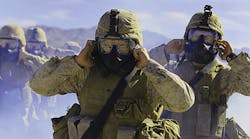As president and co-founder of The Sergeant Sullivan Center, Daniel Sullivan manages day-to-day operations and works to fund medical research, raise public awareness and provide health care education for more than 800,000 present and former U.S. service members suffering from difficult-to-diagnose post-deployment illnesses.
"There are people out there who are dying from the toxic wounds of war, and their sacrifice is going unrecognized by their country, their government and the people of the United States,” said Sullivan.
His brother, Marine Corps Sgt. Thomas Sullivan, is one of those soldiers. He was diagnosed with a psychosomatic disorder by military health care providers, and six months later, he was dead. An autopsy revealed serious damage to his heart, brain and lungs, among other organ systems, which was never detected while he was alive. The organ damage was consistent with that associated with some toxic exposures.
The military system is years behind the private sector and private occupational physicians when it comes to identifying illnesses and tying them to toxic exposures, according to Sullivan. “These are workers, and they deserve the respect and the same treatment as any other workers,” he insisted. “If this is your job for 10 years – deploying, redeploying, redeploying – it is a job and it has occupational hazards and exposures.
War is perceived as a very hazardous, emergency situation, and soldiers returning with physical wounds traditionally have been honored for their sacrifice. The U.S. Department of Defense (DOD), the U.S. Department of Veterans Affairs (VA) and the public have been slower to acknowledge that some soldiers are suffering invisible wounds, such as post-traumatic stress disorder (PTSD) and exposure to toxic chemicals.
"These soldiers, with invisible wounds, haven’t received the same honor as those suffering from more-visible wounds,” said Sullivan. “One out of three veterans are suffering from conditions that DOD and VA call ‘unexplained.’ We owe it to our veterans to conduct that research and find causes and treatments for these conditions. DOD, VA – they have the resources to do it.”
The Time is Past Due
On June 12 in a written statement, Peter Sullivan, Daniel and Thomas’ father and chair of the Sergeant Sullivan Center Science and Policy Advisory Panel, told the Defense Health Board Public Health Subcommittee, “The time is well past due for the president and the departments of defense and veterans affairs to acknowledge officially that there is a growing health crisis affecting the veterans of our nation’s wars in Afghanistan and Iraq."
According to Peter Sullivan, amputations of limbs, traumatic brain injury, PTSD (and to some extent suicide) often are referred by the Department of Defense and Veterans Affairs as “signature wounds” of the Gulf wars. By and large, both departments have taken positive action to address them, he noted.
"This cannot be said of the hundreds of thousands of former and current service members who suffer from the other significant, albeit invisible wounds: the diminution of their health due to likely toxic exposures while deployed,” said Peter Sullivan in his statement.
Daniel Sullivan noted that an organization called Burn Pits 360 has started a database of veterans who are suffering from diseases and illnesses potentially related to exposures to toxins on the field of war. “They have 3,500 registrants in a short period of time,” said Sullivan. “Imagine the database the DOD could create.”
The New Agent Orange
The day I spoke with Rosie Torres, executive director of Burn Pits 360, was a banner day for her and all others advocating for veterans and civilian workers who were suffering from pulmonary illnesses or toxic exposures. On June 19, VA launched the Airborne Hazards and Open Burn Pit Registry. Veterans and service members of the wars in the Middle East can use the registry questionnaire to report exposures to airborne hazards (such as smoke from burn pits, oil-well fires or pollution during deployment), as well as other exposures and health concerns.
Contractors were assigned the task of properly disposing of any and all trash on military installations in Iraq, Afghanistan and other locations in the Middle East. Instead of using incinerators, the contractors disposed of the waste through burn pits and in the process, exposed thousands of veterans to toxins that place them at serious risk of respiratory illnesses, cancers and other occupational diseases, according to Torres, who calls such exposures “the new Agent Orange.”
According to a VA regional training letter provided by Burn Pits 360, the Department of Defense has performed air sampling at Joint Base Balad, Iraq, and Camp Lemonier, Djibouti. According to the letter, “Most of the air samples have not shown individual chemicals that exceed military exposure guidelines.”
It is interesting to note that the air sampling performed at Balad and discussed in an unclassified 2008 assessment tested and detected all of the following: (1) particulate matter; (2) polycyclic aromatic hydrocarbons; (3) volatile organic compounds; and (4) toxic organic halogenated dioxins and furans (dioxins).
Torres told me that she’s been receiving calls and emails from veterans and service members who are trying to register on the VA site. “I am telling them to make sure they register on both the VA site and our site,” she said. “We need to get the word out and get people to register.”
Torres’s goal for her advocacy efforts is two-fold, she told me: to create a community for these service members and vets and their families to come together, and to create a database that can help prove the association between the exposures to toxins in the burn pits and elsewhere on the fields of war and the pulmonary illnesses, organ failure and cancer found in many returning service personnel and veterans.
“We have over 3,500 people registered,” she said, “and I’d say 99 percent of them have respiratory symptoms or illnesses. People are suffering. Their careers are suffering, they’re suffering financially, and DOD and the VA still won’t admit to the connection between their service and these illnesses and conditions.”
Many members of the Burn Pits 360 have stories similar to that of Torres’s husband, Army Capt. Le Roy Torres, who was told he was suffering from anxiety when he went to a War Related Illness and Injury Study Center operated by Veterans Affairs. A lung biopsy conducted outside of VA later revealed that he was suffering from constrictive bronchiolitis, a rare and disabling lung disease associated with inhalation of toxins.
“[These veterans] have significant limitations and illnesses and too often their medical issues have been dismissed,” said Torres. “It is an injustice to everyone who is suffering or who has buried their loved ones.”
On Jan. 10, 2013, President Barack Obama signed legislation into law requiring the Veterans Affairs Department to:
- Establish and maintain the aforementioned open burn pit registry for members deployed in a contingency operation in Iraq or Afghanistan who may have been exposed to toxic chemicals and fumes caused by open burn pits used for disposing solid waste.
- Include in the registry information necessary to ascertain and monitor the health effects of such exposure.
- Develop a public information campaign to inform eligible individuals about the registry.
- Periodically notify such individuals of significant developments in the study and treatment of conditions associated with such exposure.
It also requires the secretary of defense to contract with an independent scientific organization to develop reports assessing the effectiveness of actions taken to collect and maintain information on the health effects of such exposure, and submit the organization’s initial and follow-up report to Congress.
“We’re happy it’s moving in the direction it’s moving,” said Torres of the launch of the VA registry. “But there’s still resistance at DOD and VA and we need to get past that.”

